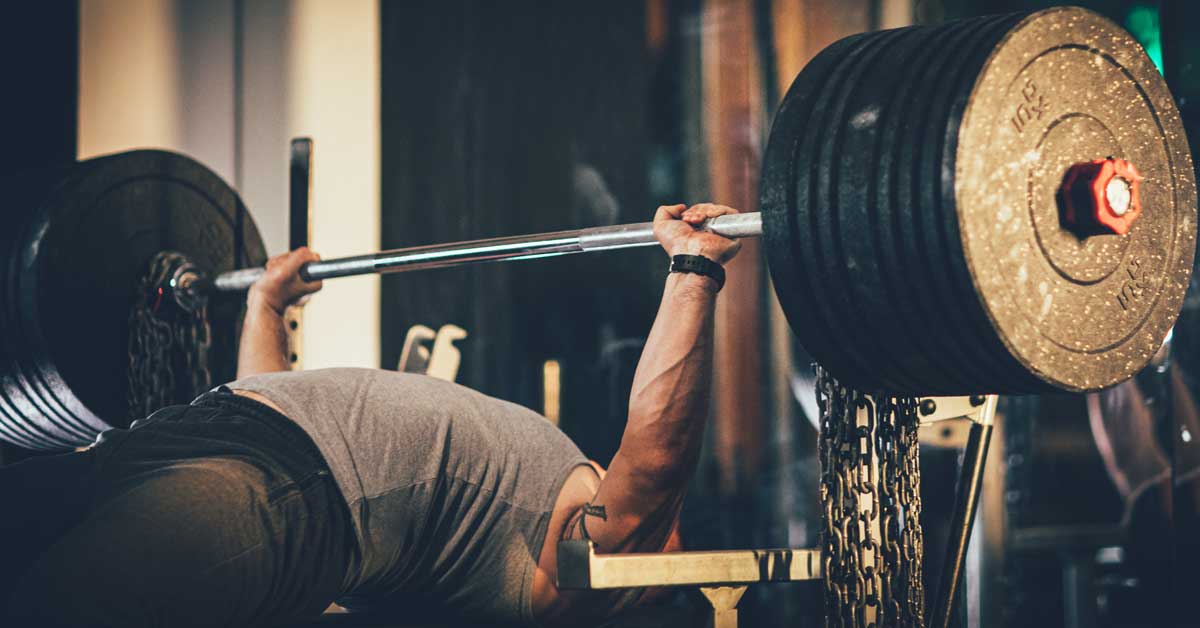The bench press exercise may be one of the most popular conditioning exercises to build upper body strength and muscle development. In the sport of powerlifting, it is one of the three main lifts used in competition, along with the squat and deadlift. The goal to try and maximize the weight successfully lifted in competition involves a combination of optimal biomechanics and muscle physiology to result in the generation of a high amount of force from the upper body. With this in mind, we will look at some of the factors that can go into the decision to find an optimal grip width to maximize outcomes.
We chose the ‘simple’ approach to investigate whether a wider grip would have a favorable effect on the mechanics and physiology of the lift and lead to potentially greater results. Share on XOur study here begins with a competitive powerlifter who was looking to improve his bench press performance. With a variety of techniques available that can have an effect on lifting performance—such as elbow position, degree of arch, speed of approach, location of the bar in relation to the shoulder and chest, etc.—we chose the “simple” approach to investigate whether a wider grip would have a favorable effect on the mechanics and physiology of the lift and lead to potentially greater results.
Materials and Methods
To tackle this issue, I used an inertial sensor (G-Sensor) and eight EMG sensors from BTS Bioengineering to track the kinematics of the bar and to analyze the neuromuscular contribution from the left and right sides of the body, respectively. I chose to examine the chest, arm, and shoulder muscles, as these are the muscles considered to have the largest contribution to the movement and that are commonly used in research about the bench press.
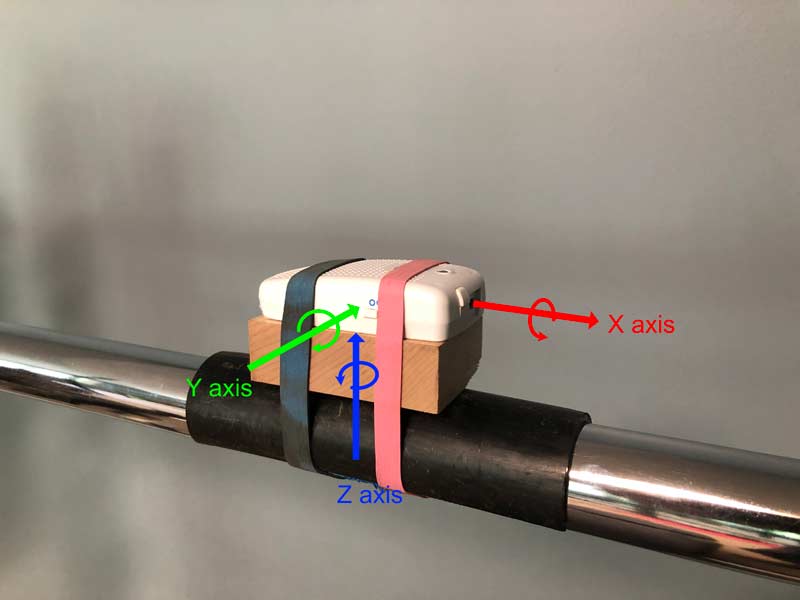
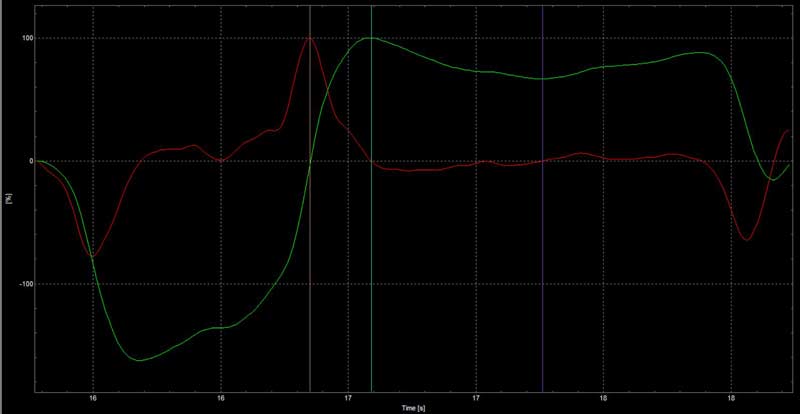
The G-Sensor was attached to the mid-point of the bar on the side opposite to the lifter. As the G-Sensor uses a triaxial accelerometer to measure acceleration, the sensor was oriented so that the Z axis was perpendicular to the bar, with the X and Y axes consequently being parallel to the bar. Positive acceleration in the Z axis is away from the ground, in the X axis, it’s toward the lifter’s left side, and in the Y axis positive acceleration is away from the lifter. In addition, the inertial sensor also contains a triaxial gyroscope and a magnetic sensor to measure angular velocity and angles along the three axes. This results in positive values when the sensor is rotated about the axis in a counterclockwise direction.
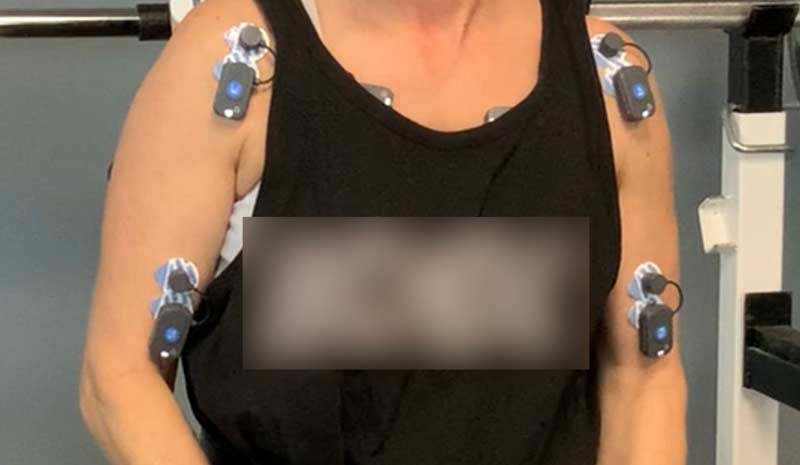
The wireless FREEEMG sensors were placed on the sternal portion of the pectoralis major, anterior deltoid, long head of the biceps brachii, and the long head of the triceps brachii according to the locations specified by SENIAM standards and Cram’s Introduction to Surface Electromyography, 2nd Edition. The sites were cleaned with alcohol, and a skin prep gel was used to ensure a strong signal.
To enable a good comparison between both lifts, we chose to perform them on the same day while keeping the electrodes in place—this reduced confounding variables that can come from replacing the electrodes and inter-day performance variability. The lift intensity was estimated to be greater than 90% MVC, and the same weight was used for the two lifts after an incremental warm-up with progressively heavier weights and rest of at least 3-5 minutes between. The grip widths varied by approximately 3.5 inches, and our lifter had trained and competed with the narrower grip. However, both grips felt similar on execution, hence the problem of choosing a “better” grip.
Both the narrow and wide grips (they varied by approximately 3.5 inches) felt similar on execution, hence the problem of choosing a ‘better’ grip. Share on XAs is common in the research, I have divided the lift into five key events:
- The beginning of the eccentric phase, defined as where both the acceleration and velocity are zero or below zero.
- The concentric portion of the lift, where velocity returns to zero.
- The start of the sticking region, where acceleration drops below zero.
- The end of the sticking region, where acceleration returns above zero.
- The end of the movement, where velocity and acceleration return back to zero.
*Note that with a sampling rate of 100 Hz, some of the events may not be exactly at zero but very close to it.
You can see that the narrow grip resulted in lower acceleration and, consequently, lower velocity throughout the lift. This resulted in a longer time to complete the repetition. There was no attempt to control speed, as the lift was to be performed at the normal pace used in competition.
Remember, the higher and lower acceleration values are a result of higher and lower forces applied to the bar (force = mass x acceleration). Since the weight was the same in the two different techniques, we can see there were substantially higher forces applied around the start of the concentric portion to the beginning of the sticking portion during the wider grip press compared to the narrow grip. The opposite was true for the eccentric portion, as there are lower forces acting on the bar to lower it (lower accelerations) at the beginning of the eccentric portion for the wider grip.
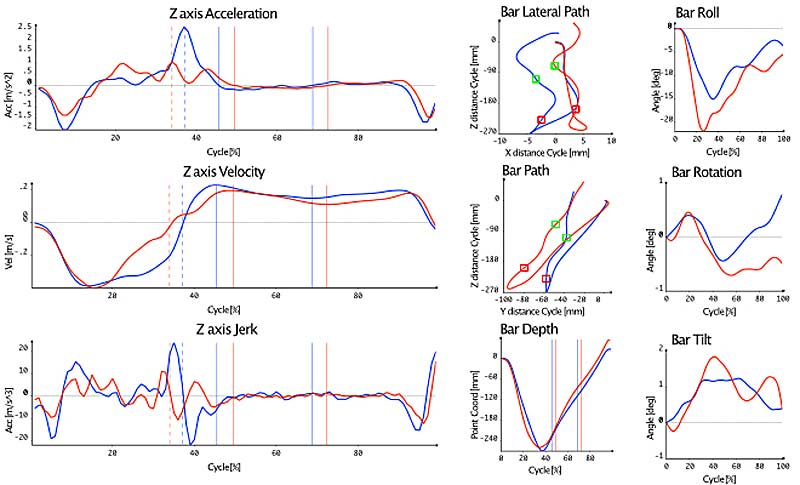
In order to lower the bar, the combined forces of the muscles need to decrease to below the force from gravity. As the bar accelerates downward, the muscles then have to increase the force to decelerate the bar to a stop and then continue to apply force to overcome gravity and lift it back up. The narrow grip required less force to move into the concentric portion of the lift because the deceleration force wasn’t as great to overcome.
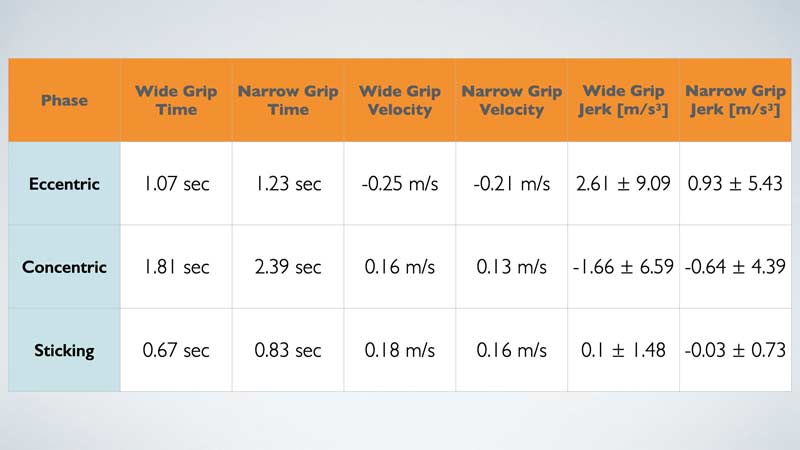
Jerk is also known as the rate of change of acceleration (calculated by taking the derivative of acceleration), which in this case would also relate to the rate of force development, since the mass of the bar is the same. Jerk can also indicate smoothness of technique during the lift. In general, a better execution or technique application will be smoother and less choppy on the bar. The best portion to compare our different techniques is the sticking region, since the acceleration and velocity are similar. Looking at the values for the different lifts, we can see a higher mean and standard deviation for the wider grip, which indicates a choppier or jerky movement during the sticking region.
Assessment and Prescription
In examining the path of the bar, the narrow grip resulted in a greater horizontal movement of approximately 40 centimeters away from the shoulder as opposed to the more vertical path of the wider grip. Vertical displacement was similar, with the wider grip being slightly deeper, most likely due to the position it touched on the chest being slightly lower. Overall, vertical displacement was greater in the narrow grip press.
Our graphs on the right give insight into how the bar tilted, rolled, and rotated during the lift. We can see the bar is very stable laterally, with more roll in the narrow grip at the bottom of the movement. Inexperienced lifters often show much less control during a maximum or close to maximum lift, with substantially more tilt and rotation compared to an elite powerlifter. Although not apparent in our case, significant tilt and rotation differences may also indicate a left/right imbalance, which should be investigated further to determine the cause.
Although not apparent in our case, significant tilt and rotation differences may also indicate a left/right imbalance with the lifter, which should be investigated further to determine the cause. Share on XNow that we have an idea how the bar moved through space, let’s take a closer look at how the muscles contributed to the movement.
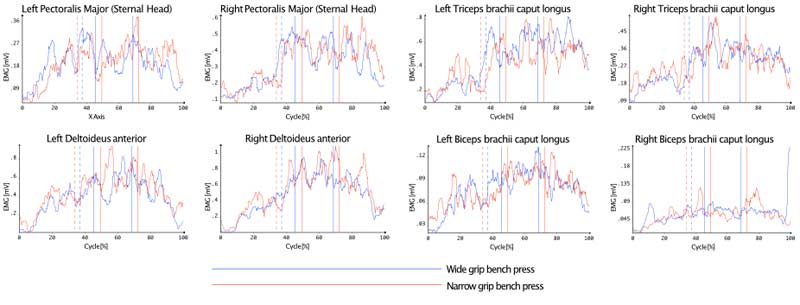
Remember that increased activation does not necessarily mean increased absolute force for the different muscles. For example, we can see that the left pectoralis had lower EMG voltages compared to the right—although that could mean there was less activation, it doesn’t necessarily mean it occurred. Our EMG sensors measure the combined action potentials of the motor units immediately under the skin, and to a certain depth within the muscle. Factors that can affect the EMG reading include:
- The electrode position in relation to the innervation zone.
- The thickness between the top of the skin and the muscle.
- The conductivity of the skin.
- The alignment of the electrodes with the muscle fibers.
These factors are controlled for by carefully landmarking the position and angle of the electrodes, as well as cleaning and preparing the skin equally at all sites. Generally, a difference within 10% is normal, with anything above 20% indicative of a possible imbalance.
In our case, the pectoralis and triceps are outside of that range. This would warrant a closer look to see if a strength difference exists in order to rule out possible electrode misalignment or differences between muscle structures. This can be done either with unilateral strength testing particular to that muscle or by performing an appropriate isometric maximal voluntary contraction (IMVC) for each of the muscles and normalizing the EMG to the peak value obtained. This would give us a better idea how the muscles work in relation to their maximal capacity while also rechecking our electrode locations and positions.
We are more concerned about how the left & right muscles activate during the two different techniques, and not so much about possible force production differences between the sides at this stage. Share on XIn addition, assessing muscle fatigue through spectral analysis and comparing the change of median frequency during the lift can also provide insight into how the muscles are responding.
Although a strength discrepancy would be relevant to the performance, our objective is to determine if a technique change could result in a better performance. We are more concerned about how the left and right muscles activate during the two different techniques, and not so much about possible force production differences between left and right sides at this stage.
In order to have a fair comparison, the results are normalized to the highest of the peak value obtained from the two attempts. This is referred to as the dynamic peak method and helps us compare the two lifts better.
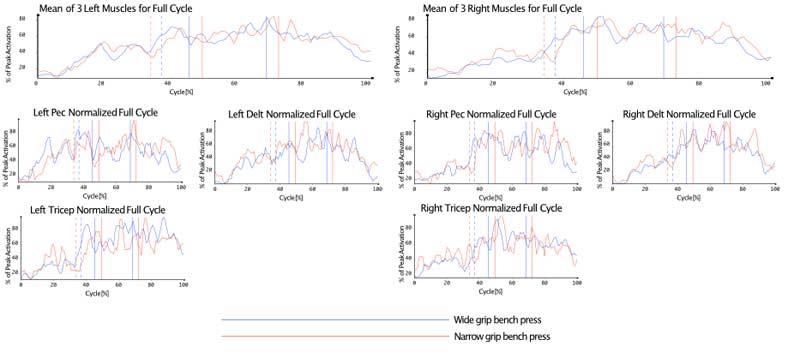
These graphs represent the normalized activity of three of the four measured muscles as well as the mean of the three prime movers (pectorals major, anterior deltoid, and triceps brachii). I chose to remove the biceps from the overall mean to remove the possible confounding effects. In the bench press movement, the biceps is generally considered to be a stabilizer as well as an antagonist, and not a major contributor to the lift.
Looking at the normalized EMG values, intuitively we would expect lower activation during the eccentric component because of the reduced force required to lower the bar combined with the mechanical advantage of the muscle fiber’s ability to generate higher tension with less activation during eccentric contractions. This would then be followed by rapidly increasing activation at the beginning of the concentric movement and continued activation in all muscle groups until the end of the sticking region. Once out of the sticking region, better biomechanics should result in less activation overall to continue to lift the bar to the finish.
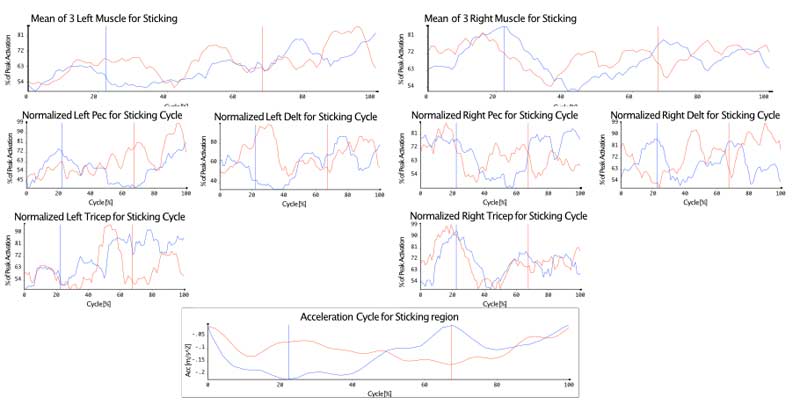
In examining the actual normalized activation patterns, our previously described general trend seems to carry over until the approach of the sticking region in both lifts. The left side appears to have a burst of activity about halfway between the start of the concentric and the start of the sticking region, and then it decreases. Activity appears to recover at about the midpoint of the sticking region and resumes its climb until the end of this region. After the sticking phase, there is a general decrease in activation to complete the movement.
In both lifting techniques, the left side hit a peak of combined muscle activity at the end of the sticking region, whereas the right side hit peak activation at the start of the sticking region. In theory, part of this initial burst of activity could be enhanced by post activation potentiation, although this is thought to dissipate by approximately 0.3 seconds after initiation (especially after factoring in electromechanical delay) and is not believed to have a large contribution in a slower movement like the bench press.
As less activation is described as a decrease in EMG amplitude and is generally associated with less force production, it is plausible that this decrease in activation contributes to the sticking portion of the lift. However, contrary to this specific issue, some studies have suggested that the decrease in acceleration is more likely caused by a poor mechanical position rather than a decrease in muscle activation.1,2 Note that the wide grip had a larger mean negative acceleration (lower force acting on the bar) than the narrow grip. In this lifter, the problem is probably compounded by less muscle activity at a time when more force is required.
The level of muscle fatigue should also be considered when trying to determine which technique may be optimal for our powerlifter, especially considering the time difference between the two lifts. Maximal exertion can rapidly decrease metabolic and neural reserves, and this can obviously affect the amount of force the muscle can generate.
Since the EMG signal is made up of many motor unit action potentials registered in the form of electric waves, it is possible to dissect the final EMG signal mathematically to give us an idea of the mean and median speed of these motor unit waveforms in the form of an overall frequency. Median frequency shifts have been widely researched in both isometric and dynamic contraction, and it is generally accepted that a lower median frequency is a result of fatigue within the muscle. This is as a result of metabolic and neural factors such as a slowing of the conduction velocity, as well as changes in recruitment patterns and motor unit size, to name a few. This can give us more information as to how much fatigue may be a factor in the final lift performance.
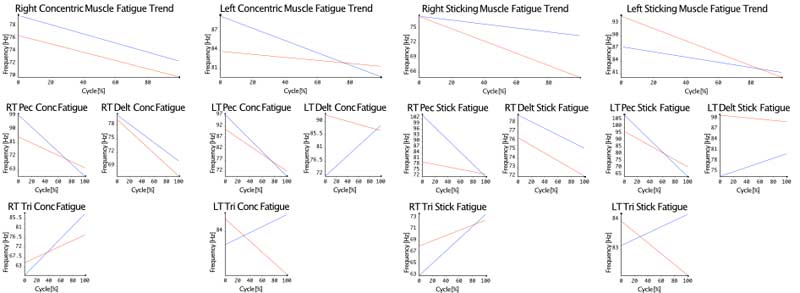
Looking at the sum of the normalized frequencies for the three prime movers in the two lifts for both the concentric and sticking portions, the narrow grip press showed a trend of decreasing values across almost all muscles except the right triceps, whereas the wider grip only suggests fatigue in the pectorals and right deltoid.
Decreasing median frequency is widely believed to be related to fatigue, while increasing median frequency is usually associated with recovery or increasing neural efficiency. These results could also lend support to further investigate the potential for a difference in strength levels between the left and right sides.
We must also consider that the narrow grip press lasted longer (timewise) and may have exhausted the muscles capacity earlier than the shorter wide grip press. Also, the wider grip press was performed after the narrow grip press, and the lifter may have experienced greater fatigue effects, which could show as an increased slope in the trend line.
Should our lifter change to a wider grip from the narrow grip? Here are some deciding factors.
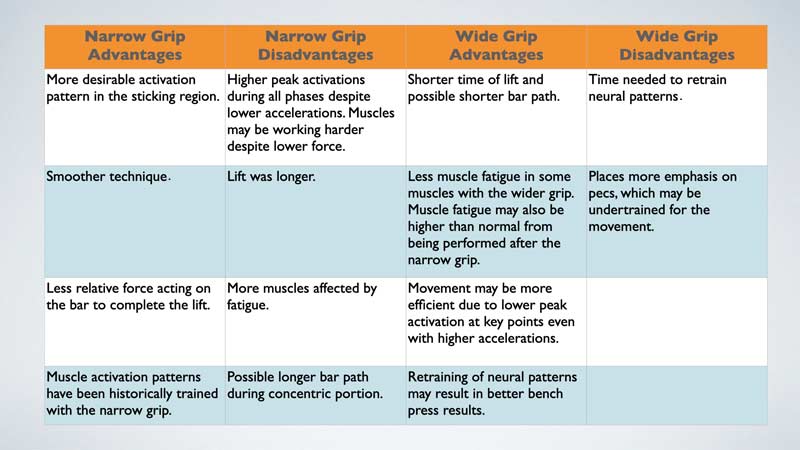
As you can see, our decision is multifactorial and has advantages and disadvantages. There appear to be more reasons against staying with a narrow grip than with the wider grip. However, retraining neural patterns can take time, which may not fit into every competitor’s schedule. Considering both attempts were perceived to be near maximal, and the narrow grip had been the historical grip used, we may get faster progress by switching to the wider grip, as we have potentially more room to improve.
If we stay with the narrow grip press, we could improve performance by increasing hypertrophy of the prime movers and addressing the apparent deactivation at the start of the sticking period. Share on XIf we stay with the narrow grip press, ways to improve performance would be to increase hypertrophy of the prime movers and address the apparent deactivation at the start of the sticking period. Hypertrophy is typically achieved by using exercises that target the muscle with an increase in volume at moderate intensities. Changing activation throughout the movement can be approached by increasing resistance at the onset of decreasing activation (chains or elastics applied to the bar using straps for the appropriate increase in resistance at the right time, manually applied resistance, machines with appropriate force curves, changes in acceleration, etc.) while minimizing techniques that can aggravate the situation such as forced reps and assisted reps.
If we switch to the wider grip, we would still do all of the above since these are universal issues; however, we might emphasize pec hypertrophy more and focus on incorporating the new grip into training while trying to minimize risk of injury during the transition. Neural adaptations in performance happen faster than hypertrophic adaptations, so we would expect an improvement in approximately six to eight weeks. This would also be a good time to retest to compare again and determine if we achieved the specified goals.
If we switch to the wider grip, we might emphasize pec hypertrophy more and focus on incorporating the new grip into training while trying to minimize risk of injury during the transition. Share on XSince there is also the possibility of a strength imbalance between the left and the right, it would also be wise to confirm this through unilateral strength testing. We could do this with an EMG assessment, with each muscle normalized to an IMVC to see how the left and right sides perform compared to their max. Although the bench press may be a maximum lift, and you might think we could just use the lift as the maximal contraction, all the muscles may not be performing at maximal activation, so an individual IMVC needs to be performed for each muscle group involved. Higher activation in a muscle group relative to its maximal force production compared between the left and right sides might confirm if the left side is working harder than the right.
Final Takeaways
It’s important to remember that the factors we’ve assessed are only one aspect of evaluating the bench press movement. Future assessments might consider how additional agonist muscles, along with antagonist muscles, activate—doing so to examine how the whole musculature contributes to the final performance. By examining antagonist muscle groups, you may find some are more or less active during the movement, thus affecting the final force production to move the bar. Also, this was just one trial, and it is usually advisable to have at least three trials to confirm the first trial wasn’t unique.
The use of new technology to help decipher complex interactions between factors that can improve performance is a constantly developing process. The fact that you can combine and sync physiological effects such as EMG results along with kinematic and dynamic information from inertial sensors opens up a wide range of possibilities that would not have been likely with observation alone.
Although the amount of data you can receive can sometimes be overwhelming, staying focused on one aspect can help keep you on track as to what information is relevant and what is not. I know for myself it has really opened my eyes to the complex process that goes on behind the scenes of a movement that seems simple, like the bench press.
Since you’re here…
…we have a small favor to ask. More people are reading SimpliFaster than ever, and each week we bring you compelling content from coaches, sport scientists, and physiotherapists who are devoted to building better athletes. Please take a moment to share the articles on social media, engage the authors with questions and comments below, and link to articles when appropriate if you have a blog or participate on forums of related topics. — SF
References
1. Elliott B., Wilson G., and Kerr G. “A biomechanical analysis of the sticking region in the bench press.” Medicine & Science in Sports & Exercise. 1989;21(4):450-462.
2. Stastny P., Gołaś A., Blazek D., et al. “A systematic review of surface electromyography analyses of the bench press movement task.” PLoS ONE. 2017;12(2):1-16.

